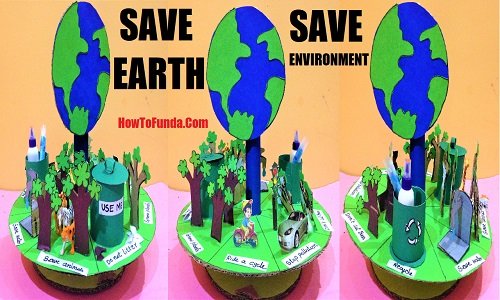Introduction:
Ladies and gentlemen, esteemed judges, and fellow guardians of our planet,
Today, I am thrilled to present a science project that dives deep into one of the most pressing challenges of our time – saving the environment.

As we gather here at this science exhibition, let us embark on a journey to understand the science behind environmental conservation, its profound significance for our world, and the urgent need for collective action to protect the environment for generations to come.
The Fragile Web of Life:
Our planet’s environment is a delicate and interconnected web of ecosystems, each contributing to the well-being of all living beings. It is this intricate balance that sustains life on Earth.
The Science of Environmental Conservation:
- Ecosystems and Biodiversity: Ecosystems are communities of living organisms and their interactions with the environment. Biodiversity, the variety of life on Earth, is essential for ecosystem stability.
- Climate Science: Understanding the Earth’s climate system and the impacts of climate change is vital for mitigating environmental crises.
- Pollution Control: The science of pollution control involves monitoring, mitigating, and preventing pollution to protect air, water, and soil quality.
- Resource Conservation: Sustainable resource management ensures that we use natural resources responsibly, preventing over-exploitation and depletion.
The Significance of Environmental Conservation:
- Climate Change: The environment is under threat from human-induced climate change, which disrupts weather patterns, increases extreme weather events, and threatens ecosystems.
- Biodiversity Loss: The ongoing loss of biodiversity due to habitat destruction, pollution, and climate change threatens the stability of ecosystems and food security.
- Pollution: Environmental pollution poses health risks to humans and wildlife, disrupts ecosystems, and damages aquatic and terrestrial environments.
- Resource Depletion: Unsustainable resource use depletes forests, fisheries, and freshwater sources, impacting global food and water security.
Challenges and Opportunities:
Environmental conservation faces numerous challenges, including political resistance, economic interests, and a lack of awareness. However, opportunities for change exist through technological innovation, advocacy, and individual actions.
Our Role in Saving the Environment:
- Sustainable Practices: Embrace sustainable living by reducing waste, conserving energy, and supporting eco-friendly products and practices.
- Advocacy: Advocate for policies and regulations that protect the environment, reduce greenhouse gas emissions, and promote conservation.
- Education: Educate ourselves and others about the importance of environmental conservation and climate action.
- Community Engagement: Engage in local environmental initiatives, conservation projects, and clean-up efforts.
Conclusion:
In conclusion, saving the environment is not just a science project; it is a moral and ecological imperative. It reminds us that our actions today will shape the world we leave for future generations.
As we explore the science of environmental conservation, let us be inspired by the interconnectedness of all life on Earth.
Let us recognize that we are stewards of this planet, entrusted with the duty to protect and preserve it. By embracing sustainable practices, advocating for change, and fostering a culture of environmental responsibility, we can collectively make a difference.
Thank you for joining me on this journey to understand the science and significance of saving the environment and the vital role we all play in securing a sustainable and thriving future for our planet.

